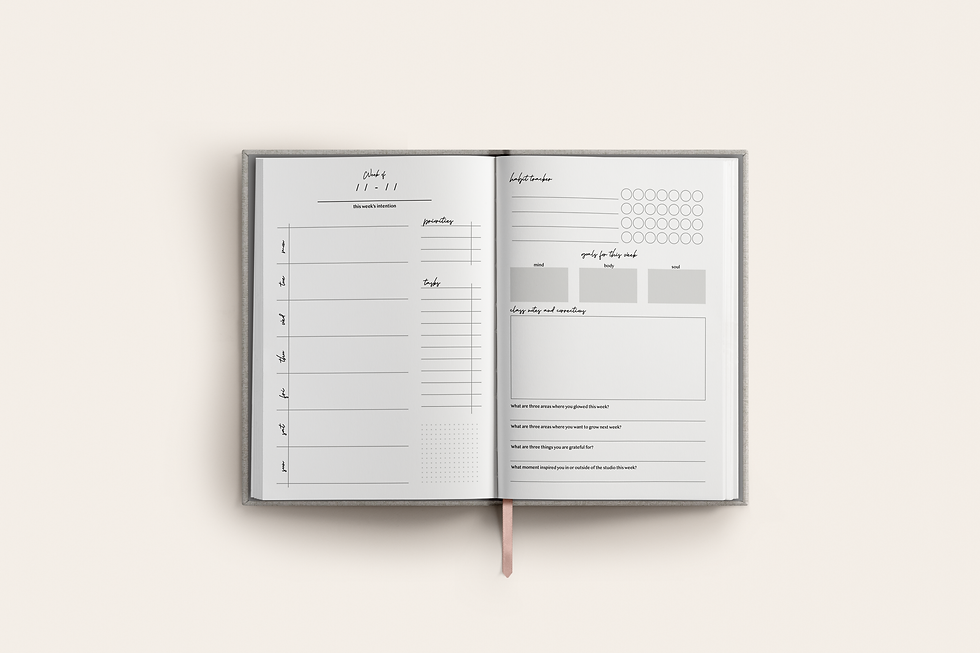Seven Mindfulness Techniques to Improve your Dance Performance
- Eliza

- Apr 8
- 4 min read

Dance is a beautiful combination of physical precision, emotional expression, and mental clarity. While technique and strength are critical components of performance, the role of mindfulness in dance is often overlooked. By integrating mindfulness practices into your dance routine, you can improve your focus, reduce performance anxiety, and take your artistry to the next level. Here are seven mindfulness techniques that can significantly enhance your dance performance, with a special focus on journaling to reflect and grow as a dancer.
1. Focused Breathing to Calm the Mind
Breathing is a foundational mindfulness technique that can help you reduce anxiety, stay focused, and regulate your energy levels. Deep, controlled breathing has the ability to activate the body’s parasympathetic nervous system, calming the mind and helping you focus before and during your performance.
Inhale deeply through your nose for four counts, hold for four counts, and exhale slowly through your mouth for four counts.
Visualize releasing tension with each breath, allowing your body to relax while maintaining clarity in your movements.
Breathing exercises are perfect for pre-performance relaxation and mental preparation, ensuring that you stay grounded in the moment.
2. Body Scanning for Awareness
A body scan is a mindfulness technique that increases body awareness by helping you detect areas of tension, discomfort, or tightness. For dancers, this is crucial for maintaining alignment, improving precision, and preventing injuries.
Stand or sit in a relaxed position.
Slowly shift your attention to different areas of your body, from your toes up to your head.
Notice areas of tightness or discomfort and consciously relax those muscles.
By regularly practicing body scans, you’ll stay more attuned to your body’s needs and maintain better posture and control during your performance.
3. Visualization to Enhance Performance
Visualization allows you to mentally rehearse your movements and performances, helping you develop muscle memory and boost confidence. This technique is especially helpful for managing nerves and preparing for high-pressure situations like auditions or recitals.
Close your eyes and vividly imagine yourself dancing the routine from start to finish.
Pay attention to details like the feeling of each movement, the music, and your emotional connection to the performance.
Visualize yourself performing flawlessly and confidently.
By consistently using visualization, you can improve your muscle memory and feel more prepared when it’s time to perform live.
4. Mindful Movement for Flow and Precision
Mindful movement helps you stay present and focused on the sensations of each movement. Instead of rushing through your routine, practice slowing down and being intentional with each step. This enhances your precision and creates a more fluid performance.
Slow down during your warm-up or practice sessions and focus on the mechanics of each movement.
Notice the alignment of your body, the stretch of your muscles, and how you transition from one movement to the next.
Try to stay connected with the flow of your body, ensuring that each move is purposeful.
Mindful movement helps you bring clarity and control into your dance, allowing for a smoother, more polished performance.
5. Gratitude Practice to Boost Confidence
Gratitude is a powerful mindfulness technique that can help you cultivate a positive mindset. When you focus on what you’re thankful for—whether it’s your body’s abilities, the opportunity to dance, or the support of your community—you shift your mental focus from self-doubt to appreciation.
Start or end each practice by listing three things you’re grateful for in your dance journey.
This could include gratitude for your growth, your instructors, your performance opportunities, or the joy of dancing itself.
Reflect on these positive aspects whenever you feel anxiety or doubt creeping in.
A gratitude practice can improve your mindset and increase your confidence, allowing you to perform with a positive, energized outlook.
6. Present Moment Focus to Reduce Performance Anxiety
One of the most effective mindfulness techniques for dancers is focusing on the present moment. Instead of worrying about past mistakes or future outcomes, grounding yourself in the present helps alleviate anxiety and allows you to perform at your best.
:
During a performance or practice, gently remind yourself to stay present.
Use cues like “right here, right now” to focus your attention on the music, your body, and the movement at hand.
If your mind starts to wander or you begin to feel anxious, refocus on your breath and the task at hand.
Staying in the present moment can help you push past performance jitters and give your best effort in every step.
7. Journaling to Reflect and Grow
Journaling is a powerful mindfulness tool that allows you to reflect on your dance experiences and track your progress. By writing about your practice, performance, and emotions, you can gain insights into areas of improvement, celebrate your successes, and process any challenges. A journal specifically designed for dancers, like the Cozy Dancer Journal, can guide you through weekly prompts that foster deeper self-awareness and personal growth. It can also help you to set quarterly and annual goals, and self-assess your progress towards meeting them.
After each practice or performance, spend a few minutes journaling about how you felt. Write about your successes, areas you want to improve, and any emotions you experienced.
Use prompts like “What went well today?” or “How can I improve my alignment in this movement?”
Over time, you’ll create a rich history of your dance journey, helping you stay motivated and focused on your progress.
The Cozy Dancer Journal is specifically designed for dancers like you, with weekly prompts that guide your reflection, mindfulness, and goal-setting. Whether you’re focusing on technique, performance, or your emotional connection to dance, journaling can help you track growth and stay mindful of your journey. To start your practice today, explore the Cozy Dancer Journal, which blends artistry with self-reflection to support your dance development.
Until Next Time... Stay Cozy!
Eliza Walsh
Founder, Cozy Dancer




Comments